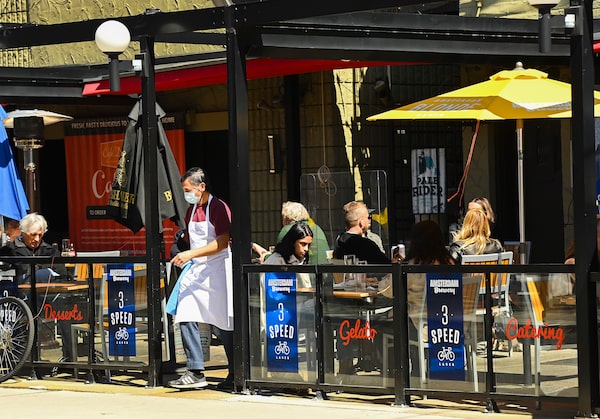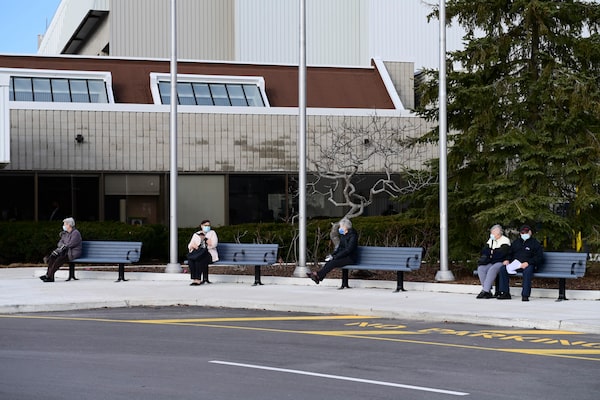People shop on packed sidewalks in Canmore, Alta., March 20, 2021.Todd Korol/The Globe and Mail
Join the Globe’s health columnist André Picard and deputy national editor Nicole MacIntyre for a Facebook Live on COVID-19 vaccines on Thursday, April 1 at 2 p.m. Send us your questions. Get a reminder on Facebook.
Nai Ling Rivas took her family to a park in Calgary’s Beltline neighbourhood on a recent sunny afternoon to celebrate her mother-in-law’s birthday. The adults chatted while spaced apart at a nearby bench while her two sons, both wearing masks, spent time on the playground.
Ms. Rivas said she was looking forward to more of these outings as winter melted away into spring, but it hasn’t turned out that way. The small birthday gathering was an exception, she said. Otherwise, her family has been mostly staying at home in the face of daily headlines about increasing COVID-19 infections and more-contagious variants.
Is my area going back into COVID-19 lockdown? A guide to restrictions across Canada
“You think, ‘Okay, the weather is getting better, maybe we can go outside,’ ” said Ms. Rivas, 39. “Now, you don’t feel like it’s the right decision.”
COVID-19 is caused by a virus called SARS-CoV-2, and as it spread around the world, it mutated into new forms that are more quickly and easily transmitted through small water droplets in the air. Canadian health officials are most worried about variants that can slip past human immune systems because of a different shape in the spiky protein that latches onto our cells. The bigger fear is that future mutations could be vaccine-resistant, which would make it necessary to tweak existing drugs or develop a new “multivalent” vaccine that works against many types, which could take months or years.
Not all variants are considered equal threats: Only those proven to be more contagious or resistant to physical-distancing measures are considered by the World Health Organization to be “variants of concern.” Five of these been found in Canada so far. The WHO refers to them by a sequence of letters and numbers known as Pango nomenclature, but in May of 2021, it also assigned them Greek letters that experts felt would be easier to remember.
ALPHA (B.1.1.7)
- Country of origin: Britain
- Traits: Pfizer-BioNTech and Moderna vaccines are still mostly effective against it, studies suggest, but for full protection, the booster is essential: With only a first dose, the effectiveness is only about 66 per cent.
- Spread in Canada: First detected in Ontario’s Durham Region in December. It is now Canada’s most common variant type. Every province has had at least one case; Ontario, Quebec and the western provinces have had thousands.
BETA (B.1.351)
- Country of origin: South Africa
- Traits: Some vaccines (including Pfizer’s and Oxford-AstraZeneca’s) appear to be less effective but researchers are still trying to learn more and make sure future versions of their drugs can be modified to fight it.
- Spread in Canada: First case recorded in Mississauga in February. All but a few provinces have had at least one case, but nowhere near as many as B.1.1.7.
GAMMA (P.1)
- Country of origin: Brazil
- Traits: Potentially able to reinfect people who’ve recovered from COVID-19.
- Spread in Canada: B.C. has had hundreds of cases, the largest known concentration of P.1 outside Brazil. More outbreaks have been detected in Ontario and the Prairies.
DELTA (B.1.617 AND B.1.617.2)
- Country of origin: India
- Traits: Spreads more easily. Single-dosed people are less protected against it than those with both vaccine doses.
- Spread in Canada: All but a few provinces have recorded cases, but B.C.’s total has been the largest so far.
LAMBDA (C.37)
- Country of origin: Peru
- Traits: Spreads more easily. Health officials had been monitoring it since last August, but the WHO only designated it a variant of concern in June of 2021.
- Spread in Canada: A handful of travel-related cases were first detected in early July.
If I’m sick, how do I know whether I have a variant?
Health officials need to genetically sequence test samples to see whether it’s the regular virus or a variant, and not everyone’s sample will get screened. It’s safe to assume that, whatever the official variant tallies are in your province, the real numbers are higher. But for your purposes, it doesn’t matter whether you contract a variant or not: Act as though you’re highly contagious, and that you have been since before your symptoms appeared (remember, COVID-19 can be spread asymptomatically). Self-isolate for two weeks. If you have the COVID Alert app, use it to report your test result so others who may have been exposed to you will know to take precautions.
Need more answers? Email audience@globeandmail.com
Ms. Rivas lets her children decide whether to wear masks on the playground. They wear them all day at school and they need a break, she said. Eleven-year-old Benjamin says he’s too nervous to be on the playground without one.

People sit on the outdoor patio at a restaurant in Little Italy in Toronto on March 30, 2021.Nathan Denette/The Canadian Press
Rapidly increasing infections across the country and the growing prevalence of variants are changing the equation of how to stay safe ahead of a looming third wave, including outside, which has been seen as a haven since the pandemic began.
Alberta has warned that the province has had cases of COVID-19 transmission outside, believed to be driven by the variants. And experts say that, while being outdoors is still significantly safer than inside, the variants have increased the risk everywhere.
“The weather is nice and it’s good to be able to go for a walk, but people still need to be careful, especially with these much more infectious variants,” said Anna Banerji, a pediatric infectious-disease specialist who teaches at the University of Toronto.
“Maybe what we did last year we won’t be able to do this year unless there’s enough people vaccinated.”
Dr. Banerji said it’s troubling that COVID-19 infections are increasing despite the warmer weather. The variants are a big reason, she said, as well as people getting tired of the pandemic and letting their guard down.
She also recognizes that people need to be able to socialize outside after a second wave of infections kept many people indoors and isolated over the winter.
“I think it’s important after a very long year that people do go outside and get some fresh air, and we know that it’s much safer to be outside than inside,” she said. “You still need to be quite careful.”
Alberta’s Chief Medical Officer of Health, Deena Hinshaw, has pointed to a recent increase in outdoor transmission to urge people to maintain their vigilance. Her office declined to provide more details, including the numbers of outdoor infections identified through contact tracing and how much that has increased.
Dr. Hinshaw said the cases that have been identified have involved social gatherings where people had long conversations while not wearing masks or keeping physically distanced.
“I want to be clear that socializing outside is absolutely safer than socializing inside,” she said at a recent COVID-19 briefing. “If people are outside but they are neither distanced nor wearing masks, then just being outside is not sufficient to prevent spread.”
Peter Juni, director of Ontario’s science table and a professor of medicine and epidemiology at the University of Toronto, said being outside reduces the risk of infection by about 10 times compared with doing the same thing indoors.

People wait for their appointment time to be called at a COVID-19 clinic in Ottawa on March 30, 2021.Sean Kilpatrick/The Canadian Press
The variants haven’t changed that, but he said the more contagious forms of COVID-19 are 40 to 50 per cent more infectious regardless of the setting.
What you need to know if you’re offered the AstraZeneca COVID-19 vaccine
Dr. Juni said that means things that were not good ideas before – ignoring masking and distancing while outside, dining on a patio with someone outside your household – are even worse ideas now. He worries that people are more likely to ignore the tried-and-true public health advice just because they’re outdoors.
“Promoting outdoors over indoors is not about risk elimination – it’s just about decreasing the risk and finding an optimal way to deal with the really difficult situation,” he said.
“We’re talking about the variants of concern taking over. In this situation, everybody should just continue on the same playbook.”
Michael Brauer, who teaches in the University of British Columbia’s school of population and public health, said the easiest way to stay safe outside is to follow the same recommendations people have lived with for the past year.
He said a walk outside is relatively low risk if everyone keeps their distance and wears a mask. One advantage to this is that people do not necessarily face each other while talking. Dr. Brauer said if he encounters someone outside for more than a brief interaction, he puts on a mask and expects them to do the same. And he said people should continue to avoid large outdoor gatherings.
“All of this was always true, but it’s even more important to consider with the variants,” he said. “I think many people viewed outdoors as being completely safe. It never was completely safe, it was just safer. And now it’s probably less safe than it was before.”
We have a weekly Western Canada newsletter written by our B.C. and Alberta bureau chiefs, providing a comprehensive package of the news you need to know about the region and its place in the issues facing Canada. Sign up today.
 James Keller
James Keller